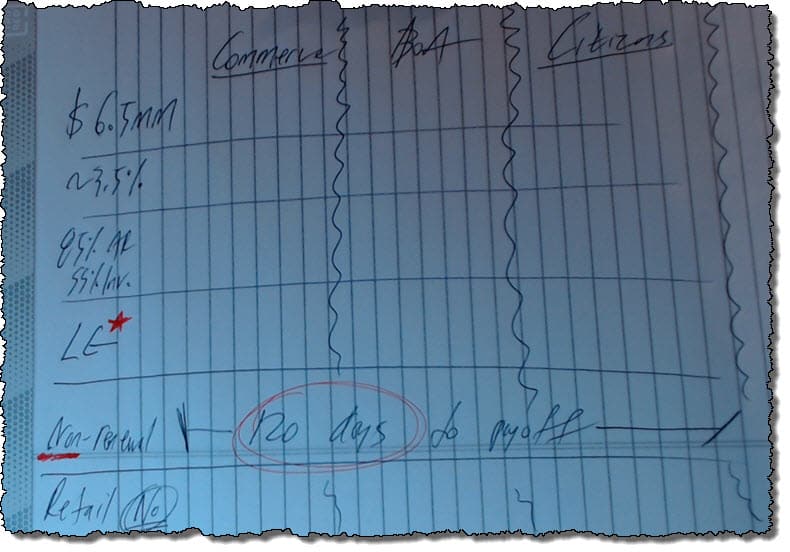Many of the CEOs I’ve served during the past 20 years are heavy consumers of cash due to the intense requirements of growing the business. On one hand, it’s fun and exhilarating. But that torrid growth pace can lead to some dubious decisions when obtaining bank financing. The CEO mindset is, “Just get me the money, I’ll figure out the consequences later.”
Perhaps we can have our bank financing as we want it and eat our cake too. It just takes a little patience, skill, and discipline. That includes eliminating bank origination fees.
Just Say No to Bank Origination Fees
We’re not talking about SBA fees. I’ve never been able to get those eliminated. Thankfully, those unnecessary costs are manageable and don’t break the bank. But what about those non-SBA loan origination fees that can range from .25 to .75 percent of the loan proceeds?
G3CFO has many aphorisms. One of my favorites is, “Give the lender everything they want, just don’t give them the bank.”
I don’t say that to be derogatory. I have many bank friends that I know, like, and trust. They are usually the type that will give on loan fees.
Why is that?
Don’t forget, banks are businesses too. They need us as much as we need them. Without loans, they cannot make money.
Before I move on, my close rate on all bank projects since 2000 is 100%. That’s because I never deliver a bad loan package to a lender. NEVER. So yes, when it comes to my loan packaging, they want the business. If I say ‘no’ to them, it will take many calls and weeks before they can find a similar loan package to close on.
So why do CEOs pay fees? They don’t ask. They are in a hurry. They want the cash. Or, they are afraid to offend the lender. My favorite lenders get it – they understand when CEOs are watching every dollar, especially when it comes to borrowing. Don’t worry about hurting feelings. Ask.
Bank Commitments – The More the Better
If I were to survey 50 CFOs obtaining new term loans (not LOC renewals), I’m 100% certain that only 15% of the projects would include three binding commitments from different banks.
How about eliminating loan origination fees and getting the best rate? Then get three loan commitments. Not one. Not two. Three. If I can get three commitments on complex financing projects during COVID, you can too under most other circumstances.
Even if the banker is a friend, I let them know I’m working the deal with other banks. That means they are going to work harder to get the business. Don’t expect them to get crazy with their underwriting criteria like WaMu before the financial crash, but don’t be surprised if they start to ease up on origination fees in order to get a good loan in their portfolio.
The biggest obstacle to obtaining multiple commitments is taking the time to find a handful of banks who want your business. The other obstacle is reliance which means staying the course once you’ve gotten that first commitment. There’s a temptation to pack it in and not keep testing the waters.
Other Loan Costs
Beyond loan origination fees, the biggest out-of-pocket cost to pay a lender is legal fees. You/me have to pay for those. Someone has to pay the attorney fees for the thick loan documents that you will probably never read. We have to pay those, not the bank.
However, just because there’s an estimate of $25,000 doesn’t mean you have to pay that much. Talk to the lender. If this is a boiler-plate deal, the costs should be minimal. I’m good at managing legal fees because I try to find out their costs upfront. I ask them to call me when they are 80% complete to ensure they don’t go over. Also, I find out how much paralegal work can be done on my end to reduce legal costs.
Legals costs can’t be eliminated, but they can certainly be managed. Don’t let this cost slip through the cracks. Manage those other, pesky, out-of-pocket loan costs just like the expenses in your own company.
Term Sheets
I rarely hear about term sheets in the context of bank financing. But we should. I like to create my own back-of-the-napkin deal points for all bank projects.
That includes rate, time, collateral, limited guarantees, covenants, and bank stipulations. Regarding stipulations, the word ‘none’ is included in my grid.
My rate is usually a range based on my understanding of the cost of money. I’ll even phone bankers to get ranges. Regarding time, that’s easy. If for equipment, I match the term to the life of the equipment minus a year or two.
Regarding collateral, this is where I wish I had time to share all of the foolish decisions on loan contracts I’ve studied over the years.
Before I explain, my strong preference is that the collateral has to match the purpose of the loan. For example, AR and inventory for a line of credit. But for term loans for longer-term projects, I never allow blanket collateral. Is blanket collateral in the bank’s term sheet? If so, walk away. Term loan collateral needs to match the financing to be obtained. If there’s too much of a gap, don’t give in by including AR and inventory. You need that for your LOC.
Banker Stipulations
I wish I had a dollar for every banker requirement stating I had to move my bank operating accounts to them. Well, I wouldn’t be rich, but I could certainly feed my Starbucks habit every day for about two months.
Nearly always, this is their strong preference and rarely a deal killer. Plus, this is something that should be addressed upfront before these conversations start getting serious.
In your preliminary term sheet, determine if you’re willing to make a bank move. More than likely, you’ve been with the same bank since setting up shop. It’s a hassle to move.
If you’re willing to make the move, don’t offer. Instead, make the bank earn the right for your retail banking. Remember, they are getting new fees. Their overnight borrowing rate might even drop a bit (albeit a few bucks). Just because this line item is in their term sheet doesn’t mean it’s not negotiable. Everything on a bank’s term sheet is negotiable.

Modeling Your Future Payments
Nearly every bank document includes a debt service coverage ratio with EBITDA either in the numerator or denominator. Ignore it. I do. If I need a waiver on a broken debt covenant, I can easily get it. How?
I’ve never given a bad bank loan package to a lender. So then why do I nix EBITDA coverage ratios?
EBITDA doesn’t pay for CapEx, income taxes, changes in working capital, or even planned owner distributions. Also, EBITDA doesn’t cover debt service. Only cash covers these expenditures.
Model out your projected operating cash flow and compare it to your debt service. For non-LOC financing, I work hard to get my CEOs at or above 1.5x. That is, operating cash flow needs to be 1.5x or higher than debt service. For some cash-starved businesses, that may seem difficult. If that’s the case, then your business needs to be recapitalized with fresh cash from you the owner.
EBITDA is the lazy way of modeling the ability to pay back loan proceeds. Unless you run a cash-centric business, you are asking for problems in your financial model if you track EBITDA instead of operating cash flow.
Never Be in a Hurry
Being patient is not easy. Most growth-oriented CEOs I have worked with want and/or need funds now. Not tomorrow, not next week, nor the following month. Now.
When we’re in a hurry to obtain bank financing, we tend to make silly mistakes. We get lax on the nuggets of wisdom I’ve shared above.
My advice, and it’s strong–unless you’re on a sinking Titanic, slow down. Get those three commitments. Find the offer that mirrors your original preliminary term sheet.
Being patient hurts in the short term. Being patient is extremely valuable in the long term.
It’s Now Your Move
Now what? Time for that second or third loan commitment? Or do you need to ask for those loan fees to be removed? Perhaps you need to refinance some poorly-financed packages from the past.
If you have a question or need more clarification, shoot me a message in the contact section.







